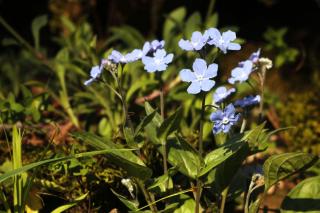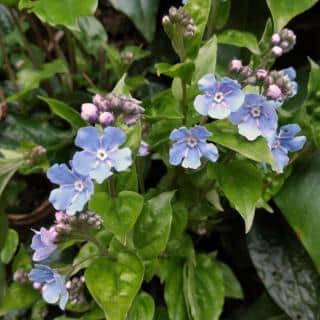

Omphalodes is a cute perennial with broad, bright green leaves. When it blooms, it’s dotted with graceful lapis-blue flowers.
Omphalodes cappadocica facts
Name – Omphalodes cappadocica
Family – Boraginaceae
Type – perennial
Bearing – crawling mound
Height – around 6 to 8 inches (15 to 20 cm)
Planting density – 4 to 6 plants per sq. yard (m²)
Exposure – shade to part shade
Soil: any type, but with high levels of humus – Flowering: April, May
Ideal for shade beds, the cute flowers of the Omphalodes cappadocica are a spitting image of forget-me-not.
 Omphalodes revels in soil that contains lots of organic material.
Omphalodes revels in soil that contains lots of organic material.
If you want to fill the area up visually right from the start, go for 8 plants instead.
When growing in pots, follow the same steps. However, pour about two inches (5 cm) of clay pebbles or gravel at the bottom of the pot to make sure drainage is perfect.
 Young specimens have to stay cool, so you have to ensure constant moisture and watering over the first years. Once it’s properly settled in, though, Omphalodes becomes very drought-resistant.
Young specimens have to stay cool, so you have to ensure constant moisture and watering over the first years. Once it’s properly settled in, though, Omphalodes becomes very drought-resistant.
In Spring, remember to top-up nutrients with fresh compost or soil mix. Spread it along the surface, and rake the soil lightly. If you’re growing Omphalodes in a container, plan a repotting session every 2 to 3 years to renew the soil. In other years, add a bit of nitrogen-rich fertilizer in Spring. For Fall, complement with phosphorus (P) fertilizer instead.
Clump division is quick and easy, and it’ll give you the best results, too.
You can divide your plants in Spring or in Fall. Again, it’s important to check that it gets enough water after the planting.
When Spring comes along, slugs and snails are the only threats to Omphalodes. They devour young shoots and keep the plant from developing normally.
Omphalodes cappadocica is excellent both in a pot and in flower beds. Just the right choice for a blue ground cover at the foot of a tree or shrub! Indeed, it doesn’t fear crowding from weeds and other plants, and quickly takes control of its allotted space. Naturally, it also pairs perfectly well with other shade plants such as Bergenia, Hosta, ferns, etc.
This plant loves rich soil, so try to topdress it with rich compost at least once a year.